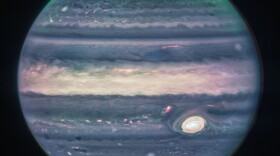Starting at 1am early Friday morning (October 21st) and lasting until dawn you can catch a glimpse of the Orionid meteor shower. Named after the constellation Orion, each meteor from the shower will have a path that viewers can draw backwards to the hunter in the sky. The meteors are particles of Haley's Comet. "Most of them are about the size of a sand grain," says Bob King. "It's traveling at such a high speed... and that translates to heat... it's like a car hitting a brick wall."
When we think of a shower – such as a rain shower – we might visualize all of the debris cascading in one direction, but here on earth we’re not so much watching the shower as we are colliding with it. “It's like driving into a rainstorm or a snowstorm," says King. "Ahead of you it looks like the snow is coming from a point in the distance... the earth is moving through that debris." As such, the meteors may be seen going in any given direction.
An early alarm clock might serve observers best as Orion will be higher in the sky as dawn approaches. "I usually tell people to spend about an hour," says King. "Sometimes there are these gaps where it's really quiet... bundle up, get your coffee or hot chocolate, get out a folding chair... and just kick back."








